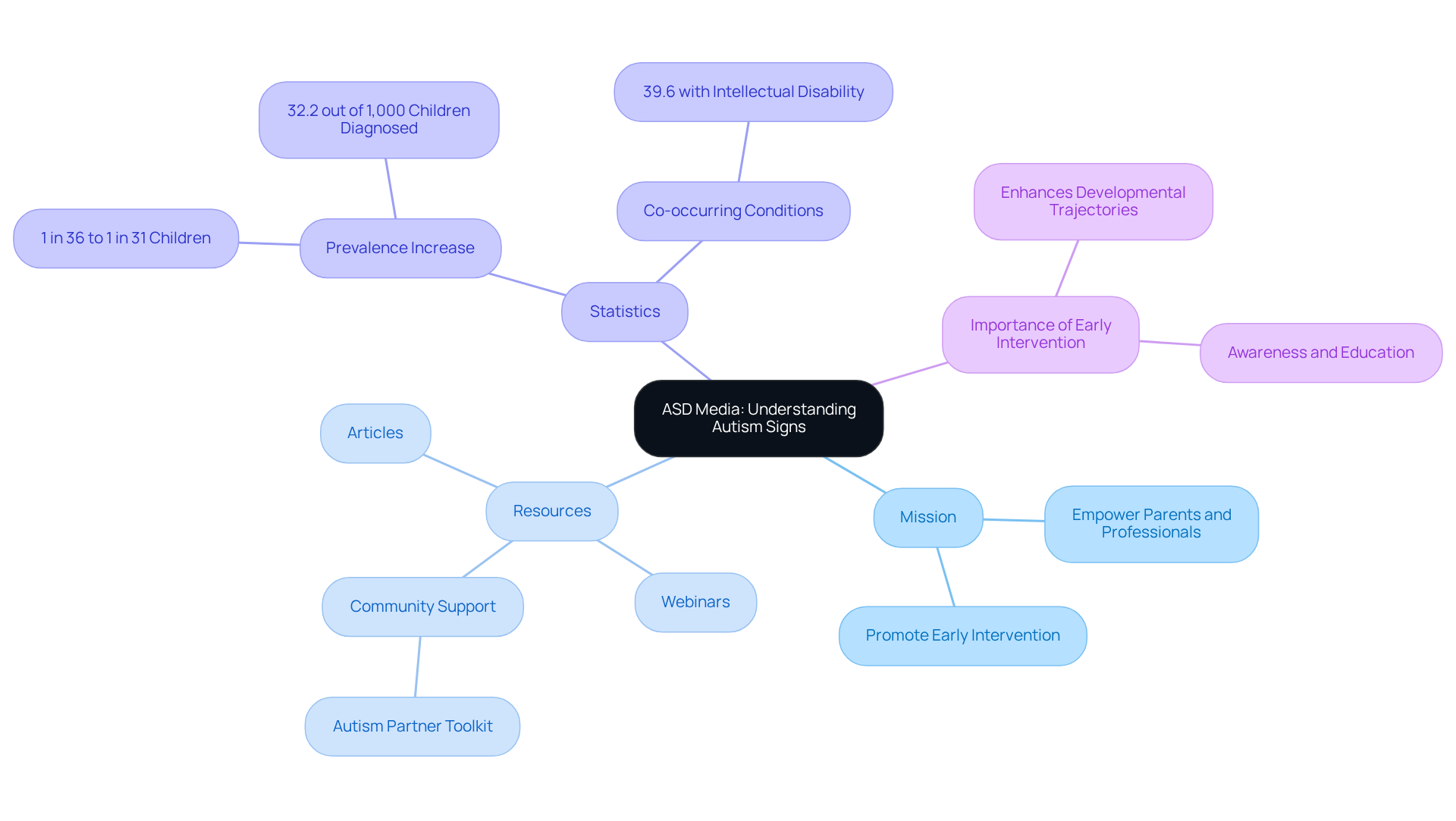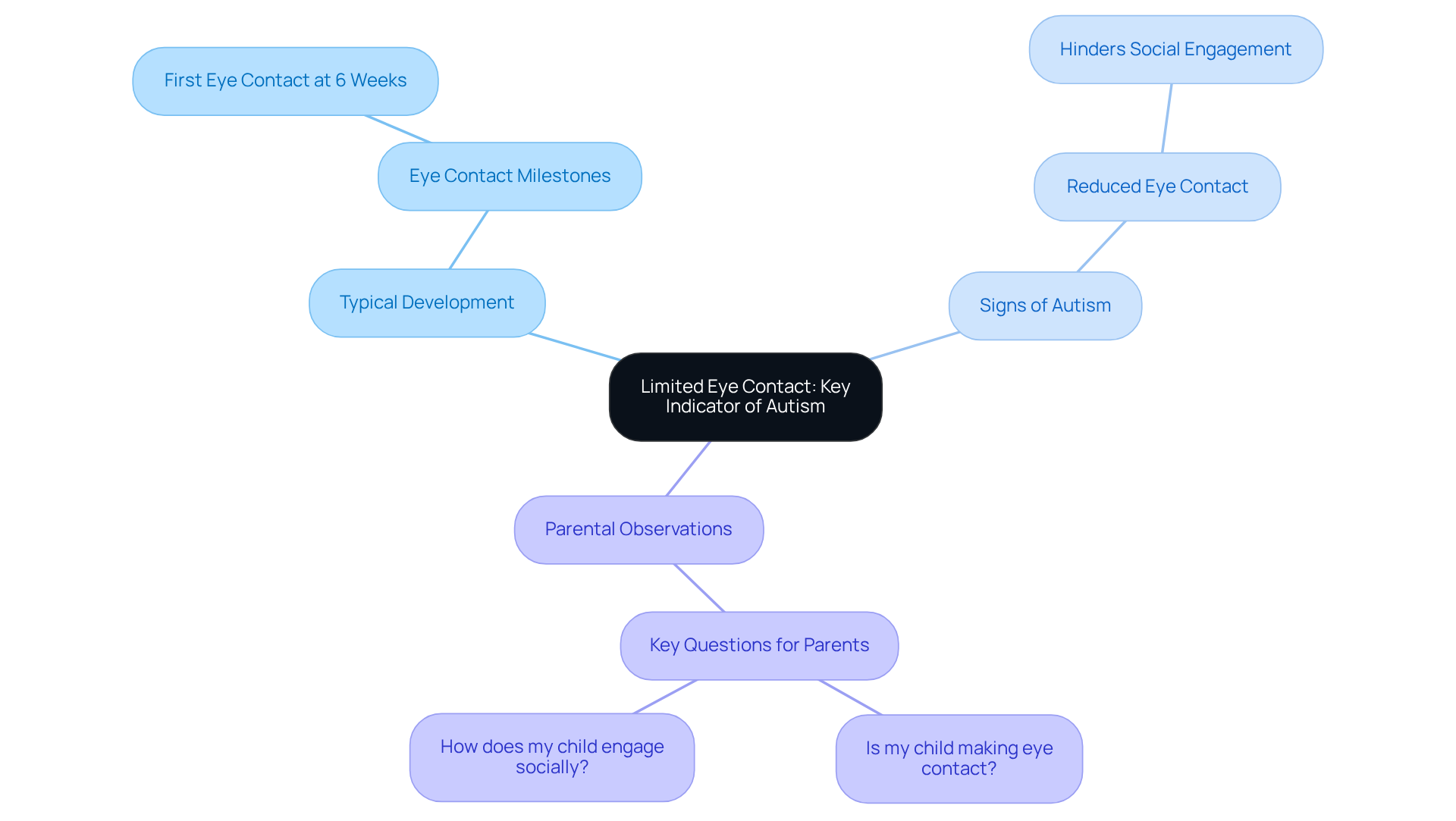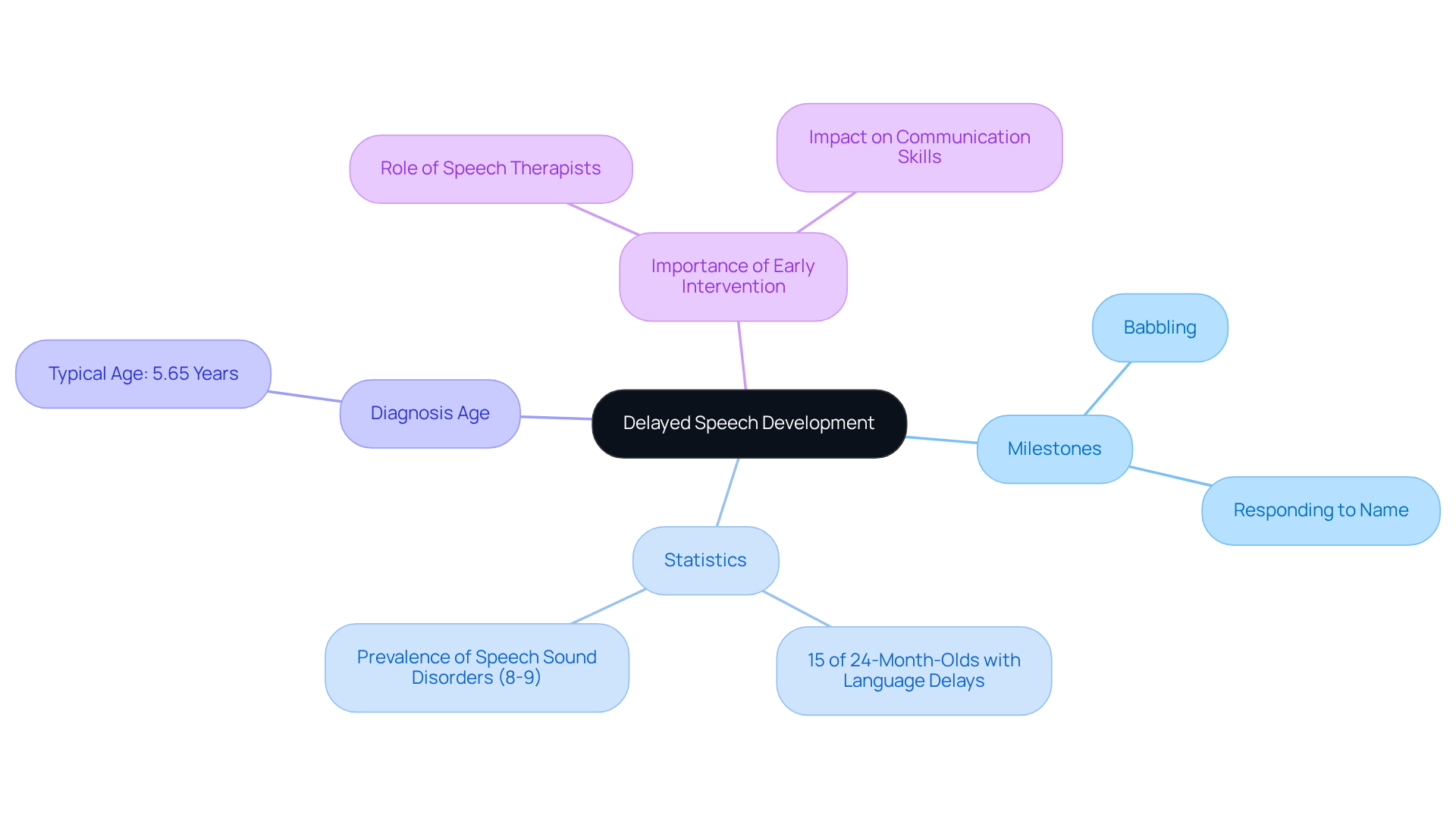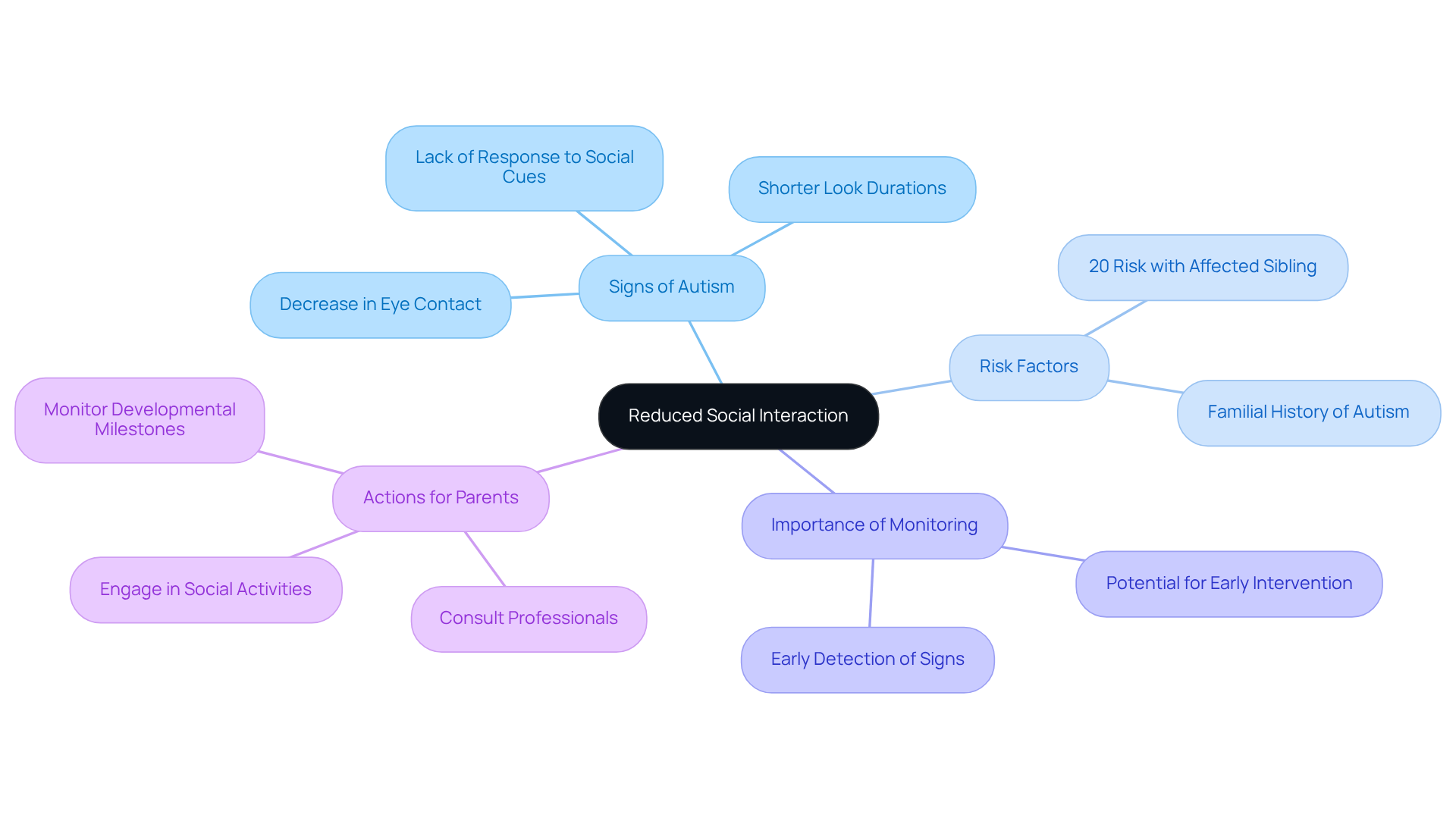Overview
This article aims to support parents by identifying the signs of autism in 9-month-old infants, highlighting the critical importance of early detection for timely intervention. By recognizing these early indicators, parents can play a vital role in their child's development.
The early indicators include:
- Limited eye contact
- Delayed speech development
- Reduced social interaction
- Repetitive movements
It’s essential to remember that your observations matter immensely in recognizing these signs. Sharing your concerns can facilitate professional evaluations, ensuring your child receives the support they need. Your journey in understanding these signs is not just about identifying challenges; it's about fostering a nurturing environment where your child can thrive.
If you notice any of these indicators, consider reaching out to a healthcare professional for guidance and support. Together, we can create a brighter future for our children.
Introduction
In a world where awareness of developmental disorders is growing, understanding the early signs of autism in infants has become increasingly vital. Recent statistics reveal that 1 in 31 children may be affected, prompting parents to seek knowledge to navigate this intricate landscape. This article presents a quiz designed to assist parents in identifying key indicators of autism in their 9-month-old children, providing essential insights into early intervention and support.
But what if the signs are subtle or easily missed? Recognizing these early warning signals could mean the difference between timely support and missed opportunities for development.
About ASD Media: Essential Resources for Understanding Autism Signs
At ASD Media, we are deeply committed to enhancing the application of ABA therapy by providing vital resources and insights into developmental disorders. Our mission is to empower parents and professionals with the knowledge necessary to identify the signs of autism in 9 month old quiz, which is crucial for ensuring timely intervention. Recent statistics reveal a concerning rise in the prevalence of developmental disorders, increasing from 1 in 36 to 1 in 31 children. This underscores the urgent need for prompt diagnosis and support.
We offer a rich array of resources, including:
- Articles
- Webinars
- Community support initiatives like the Autism Partner Toolkit
Through these offerings, ASD Media fosters an inclusive environment where individuals can share their experiences and learn from one another. This collaborative spirit is essential for effectively navigating the complexities of diagnosing and supporting developmental disorders, ultimately leading to better outcomes for children and families.
Moreover, research consistently shows that early intervention significantly enhances developmental trajectories. This makes awareness and education indispensable for parents striving to recognize the signs of autism in 9 month old quiz and access necessary support. As Dr. Temple Grandin poignantly emphasizes, understanding and empathy are fundamental in assisting individuals with developmental disorders. We invite you to join us in this journey of learning and support, as together, we can make a meaningful difference.

Limited Eye Contact: A Key Indicator of Autism in Infants
One of the earliest signs of autism in 9 month old quiz is limited eye contact, which is a crucial aspect of their social development. Typically, babies begin to make eye contact around six weeks of age, which is an exciting milestone for parents. However, it's important to note that infants who may later be identified with this condition often show reduced eye contact, which could be considered one of the signs of autism in 9 month old quiz. This can hinder their ability to engage socially and connect with those around them.
As a caring parent, observing your child's eye contact during interactions can help you recognize the signs of autism in 9 month old quiz, which provides valuable insights into their social development. Are they making eye contact with you or others? This simple observation can be a key indicator of how they are progressing socially. If you notice any concerns, remember that you are not alone, and there are resources and support available to help you navigate this journey.

Delayed Speech Development: Recognizing Early Warning Signs
Delayed speech development can serve as a critical early warning sign of autism, which many parents may explore through a signs of autism in 9 month old quiz. By nine months, most infants begin to babble and respond to their names, marking important milestones in their communication journey. However, if a child shows minimal vocalization or does not respond, it may be time to take the signs of autism in 9 month old quiz for further assessment. Research reveals that around 15% of 24-month-olds exhibit language delays without a clear cause, and this statistic reflects a broader trend where roughly 15% of all youngsters face language delays. This underscores the importance of closely tracking the signs of autism in 9 month old quiz.
The typical age for diagnosing children with speech and language delays is approximately 5.65 years, which highlights the necessity for prompt intervention. Early intervention is crucial; it can significantly enhance communication skills and support language development, ultimately influencing a child's overall development trajectory. Speech therapists often emphasize that nurturing vocalization in infants is vital for establishing foundational language skills. As one compassionate speech therapist noted, 'Promoting early vocalization is essential for fostering robust communication skills that can aid in alleviating future difficulties related to developmental disorders.'
If you find yourself concerned about your child's speech development, know that you are not alone. Seeking support and resources can make a meaningful difference in your child's journey.

Reduced Social Interaction: Understanding Engagement Deficits
Limited social interaction can be concerning for parents, as it is a characteristic of certain developmental conditions. Infants often show decreased interest in engaging with caregivers or peers, which can be alarming. Research suggests that infants who later face developmental challenges may demonstrate significantly shorter peak look durations to faces, indicating a potential lack of attention to social stimuli. If your child does not respond to social cues—like smiling or cooing back when spoken to—it's important to be vigilant. This absence of participation may be one of the signs of autism in 9 month old quiz, warranting additional monitoring and possibly early intervention.
Child psychologists emphasize the importance of recognizing the signs of autism in 9 month old quiz, as these early indicators can lead to cascading effects on social communication development. Recent studies have shown that deficits in social engagement during infancy are often linked to later diagnoses of developmental disorders. This highlights the significance of closely monitoring social interactions in the first year of life. It's worth noting that nearly 20% of infants with an older sibling identified with such conditions are at risk of developing them as well. Therefore, maintaining awareness and taking proactive steps is crucial for families with a history of these disorders.
As a parent, your observations matter. If you notice any concerning signs, consider reaching out to a professional for guidance and support. Early intervention can make a significant difference in your child's development, fostering a nurturing environment where they can thrive socially and emotionally.

Repetitive Movements: Identifying Behavioral Patterns in Infants
As parents, noticing repetitive actions in your little ones, such as hand-flapping, rocking, or spinning, can be concerning. These behaviors are important and can be assessed through a signs of autism in 9 month old quiz, with studies indicating they can emerge as early as six months. They often serve as a way for children to self-soothe or express excitement. In fact, research shows that about 46% of kids with developmental disorders are likely to exhibit such repetitive behaviors. This highlights the importance of closely observing your child’s movement patterns.
It’s crucial to understand that unusual repetitive behaviors may require professional consultation. Behavioral therapists suggest that if you notice these patterns, seeking further evaluation can be beneficial. Identifying the signs of autism in 9 month old quiz behaviors early opens the door to timely interventions, which can significantly enhance outcomes for individuals on the spectrum.
If you’re feeling uncertain or overwhelmed, remember you’re not alone. Many parents share similar experiences, and there are resources available to support you. By staying informed and proactive, you can help your child thrive.
Limited Emotional Expression: Recognizing Atypical Responses
Recognizing restricted emotional expression can be a crucial indicator of a developmental disorder. As parents, it's important to remember that infants typically convey joy, sadness, and frustration through their facial expressions and vocal sounds. However, children exhibiting signs of autism in 9 month old quiz may show fewer emotional reactions or find it challenging to recognize feelings in others. This can be concerning, and as a caring parent, you should pay close attention to your child's emotional responses. If you notice any unusual patterns, don't hesitate to seek guidance. Understanding and addressing these emotional cues can make a significant difference in your child's development.

Milestone Tracking: Assessing Developmental Progress
Tracking developmental milestones is essential for understanding your child's growth and identifying any potential delays. As a parent, it's important to recognize key milestones for infants, such as:
- Responding to their name
- Making eye contact
- Engaging in social play
Did you know that studies indicate about 1 in 6 youths in the U.S. is identified with at least one developmental delay? This statistic underscores the importance of early detection. By regularly monitoring these milestones, you can spot any delays early on, allowing for timely intervention and support.
Experts emphasize that early intervention can significantly improve outcomes for young individuals, especially those identified through a signs of autism in 9 month old quiz. For instance, case studies reveal that structured support systems, like Early Intervention programs, can help children catch up with their peers. Pediatricians advocate for using developmental screening tools, such as the Ages and Stages Questionnaires (ASQ), to assess whether your child is on track.
By actively engaging in milestone monitoring, you play a vital role in your child's development and well-being. Your involvement can make a difference, so don't hesitate to reach out for resources and support. Together, we can ensure that every child has the opportunity to thrive.
Parental Observations: The First Step in Identifying Autism
Caregiver observations play a vital role in the early detection of developmental disorders. Often, guardians are the first to notice unusual behaviors or developmental delays in their children. Research indicates that 50.3% of individuals with autism receive an assessment by age 36 months, underscoring the significance of early detection. By keeping a detailed journal of observations—documenting social interactions, communication attempts, and emotional responses—caregivers can significantly assist healthcare professionals during evaluations.
Child psychologists emphasize that insights from caregivers lead to more accurate diagnoses, as they provide context that clinical evaluations might overlook. For instance, guardians who track developmental milestones and challenges can offer a clearer picture of their child's behavior, which is essential for timely intervention. Statistics reveal that 92% of parents report that positive shifts in perspective help them navigate challenging days, reinforcing the importance of their role in the diagnostic process.
Moreover, the median age for the first recognized diagnosis in children with autism is 47 months, highlighting the need for prompt identification. Findings from the ADDM Network show that individuals born in 2018 had a higher cumulative incidence of ASD diagnosis by age 48 months compared to those born in 2014, indicating trends in early identification. Additionally, 68.4% of 8-year-olds with ASD had a recorded diagnostic statement, emphasizing the importance of thorough documentation by caregivers.
By actively engaging in their child's developmental journey, caregivers can ensure that their insights significantly contribute to assessments related to neurodevelopmental disorders. Your observations matter, and together, we can create a supportive environment for our children to thrive.
Professional Evaluations: Seeking Expert Guidance for Diagnosis
When it comes to your child's development, seeking expert assessments is vital for achieving an accurate diagnosis. If you have any concerns, remember that consulting with pediatricians or specialists in child development can be a reassuring step. These caring professionals are equipped to conduct thorough evaluations, including:
- Developmental screenings
- Behavioral assessments
to help determine if further support is needed. Your child's well-being is worth the effort, and taking action can lead to positive outcomes.
Utilizing Support Resources: Connecting with Autism Communities
For caregivers navigating the challenges of developmental disorders, seeking assistance resources is essential. Connecting with autism communities, whether through local support groups or online forums, offers a wealth of valuable information and emotional support. These shared experiences can make a significant difference.
ASD Media stands out as a vital resource, helping parents discover the support they need. By fostering a sense of community and collaboration, it empowers families to feel less isolated in their journey.
Conclusion
Understanding the signs of autism in a 9-month-old child is essential for parents who wish to nurture their child's healthy development. Early detection is key; recognizing these indicators can lead to timely interventions that significantly enhance outcomes. By staying vigilant and informed, caregivers can play a vital role in their child's developmental journey.
Key insights highlighted throughout the article underscore the importance of:
- Limited eye contact
- Delayed speech development
- Reduced social interaction
- Repetitive movements
as potential signs of autism. Parents are encouraged to actively monitor their child's milestones and emotional expressions, as these observations can provide crucial context for healthcare professionals. Additionally, seeking professional evaluations and utilizing community resources can further support families in navigating the complexities of autism.
Ultimately, fostering awareness and understanding of autism signs benefits not just individual families but also contributes to a broader culture of support and empathy for those affected by developmental disorders. By engaging with available resources and communities, parents can ensure they are not alone in this journey, empowering themselves and their children to thrive.
Frequently Asked Questions
What is the mission of ASD Media?
ASD Media is committed to enhancing the application of ABA therapy by providing vital resources and insights into developmental disorders, aiming to empower parents and professionals with the knowledge necessary to identify the signs of autism.
Why is it important to recognize the signs of autism in infants?
Recognizing the signs of autism in infants is crucial for ensuring timely intervention, which can significantly enhance developmental trajectories and improve outcomes for children and families.
What resources does ASD Media offer for understanding autism?
ASD Media offers a variety of resources, including articles, webinars, and community support initiatives like the Autism Partner Toolkit.
What is a key early indicator of autism in infants?
Limited eye contact is one of the earliest signs of autism in infants, as it can hinder their ability to engage socially and connect with others.
At what age do babies typically begin to make eye contact?
Babies typically begin to make eye contact around six weeks of age.
What does delayed speech development indicate in relation to autism?
Delayed speech development can serve as a critical early warning sign of autism, as most infants begin to babble and respond to their names by nine months.
What percentage of 24-month-olds exhibit language delays without a clear cause?
Research reveals that around 15% of 24-month-olds exhibit language delays without a clear cause.
When is the typical age for diagnosing children with speech and language delays?
The typical age for diagnosing children with speech and language delays is approximately 5.65 years.
How can early intervention impact a child's development?
Early intervention can significantly enhance communication skills and support language development, influencing a child's overall developmental trajectory positively.
What should parents do if they are concerned about their child's speech development?
Parents who are concerned about their child's speech development are encouraged to seek support and resources, as they can make a meaningful difference in the child's journey.




